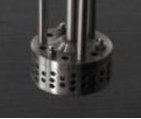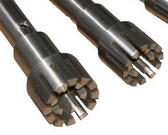Home › Cosmetic Science Talk › Formulating › General › different use of homogenizer working head
-
different use of homogenizer working head
Posted by angelz on September 11, 2015 at 4:04 pmhi, i’m new in this forum.. i want to buy a lab homogenizer but, there is 2 type of working head most commonly sold buy the supplier..
what is the different of these working head ?
what is the better one for making lotion or cream or gel emulsion ?

thank you
VitalikButerin replied 6 years, 1 month ago 7 Members · 13 Replies -
13 Replies
-
I did a lot of research trying to find the best homogenizer for cosmetics. In the end, I decided to go with a Silverson mixer/homogenizer because it seems to be well-regarded in the industry and especially with the group here. If you buy one, they include several working heads that you can easily change depending on what you’re trying to make.
-
What does the mixer manufacturer say about the possible uses for both mixing heads?
-
from the seller description both of them said ” homogenizer emulsifier”
i want to know opinion from who had use those head..
the difference i have found only that the left ( the bigger ) have a rotate speed like until 15000 rpm
but the right ( the smaller ) have a faster rotate speed like from 1000-50000 rpm..
-
I use both of these types of homogenizers. The homogenizer on the right is really good for making small samples … 300 grams or so. But, I had to have a machinist build a custom “emulsification cage” for it because that homogenizer head, as designed, pulls lots of air into your emulsions.So, basically, I had a machinist make a “Silverson Workhead” with an emulsor screen (just like the homogenizer on the left) that fit onto the homogenizer on the right. Solved the problem.
-
thank you for the comment.. so in conclusion the head on the left is still better than the right ?
i am thinking to make about 500-2000 gram lotion/ cream/ gel.. so i better get the homogenizer with the head like on the left ?
-
I would not say that … the head on the left works just a well as the head on the right, provided that you build a custom-machined emulsor housing for the head on the left. To give you an idea, it cost me $100 to have the custom head machined for the head on the left. Without this custom head, you will not be happy with the results from the head on the left compared to the head on the right.
-
i got little mixed up
so you say the better is.. the head on the left with the head on the right inside it ?
-
Watch this video, it may help you better understand my comments:
-
@MarkBroussard, thank you. That was helpful to me.
And now, I have worked up the courage to ask what may well be a dumb and obvious question to you guys. I bought a used Sorvall Omni Mixer/Homogenizer. I found instructions how to dissemble and clean the generator probes. Haven’t yet as I’m afraid I’ll harm them but at least I found instructions. I can not find much other info. Big question is - is there a separate chuck that can be assembled to the unit to enable other shafts with different propellers to be used? Or is it meant solely as a homogenizer? FYI, it works like a dream as a homogenizer and I have a separate variable speed control unit. Thanks for any info and tips.
-
MarkBroussard said:@angelz:I use both of these types of homogenizers. The homogenizer on the right is really good for making small samples … 300 grams or so. But, I had to have a machinist build a custom “emulsification cage” for it because that homogenizer head, as designed, pulls lots of air into your emulsions.So, basically, I had a machinist make a “Silverson Workhead” with an emulsor screen (just like the homogenizer on the left) that fit onto the homogenizer on the right. Solved the problem.
How much did this cost to reverse engineer,?
-
The rotor/stator head on the left most closely matches the industrial scale units we have in general use. Silverson carries different shear-head combos for these. Missing from this thread is scale-up speed. Virtually all powered industrial homogenizers run at 3500 rpm, and that is with a 15hp/460V/3phase motor. A scant few may go to 6000 rpm. I’ve had to school many a bench chemist on this when they say “Wheee, look how well it worked at 15,000 rpm!” If you cannot scale-up then why bother unless it is for home use?
-
chemicalmatt said:The rotor/stator head on the left most closely matches the industrial scale units we have in general use. Silverson carries different shear-head combos for these. Missing from this thread is scale-up speed. Virtually all powered industrial homogenizers run at 3500 rpm, and that is with a 15hp/460V/3phase motor. A scant few may go to 6000 rpm. I’ve had to school many a bench chemist on this when they say “Wheee, look how well it worked at 15,000 rpm!” If you cannot scale-up then why bother unless it is for home use?
Do you use Chinese made ones or silverson ones?
Log in to reply.

